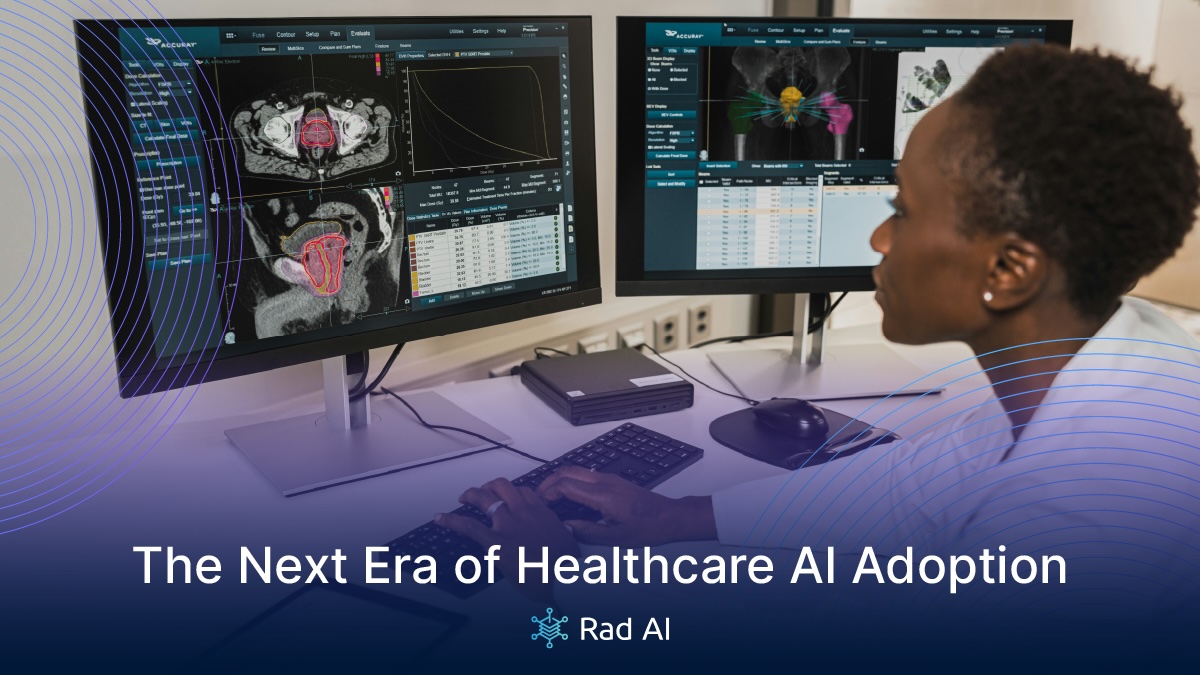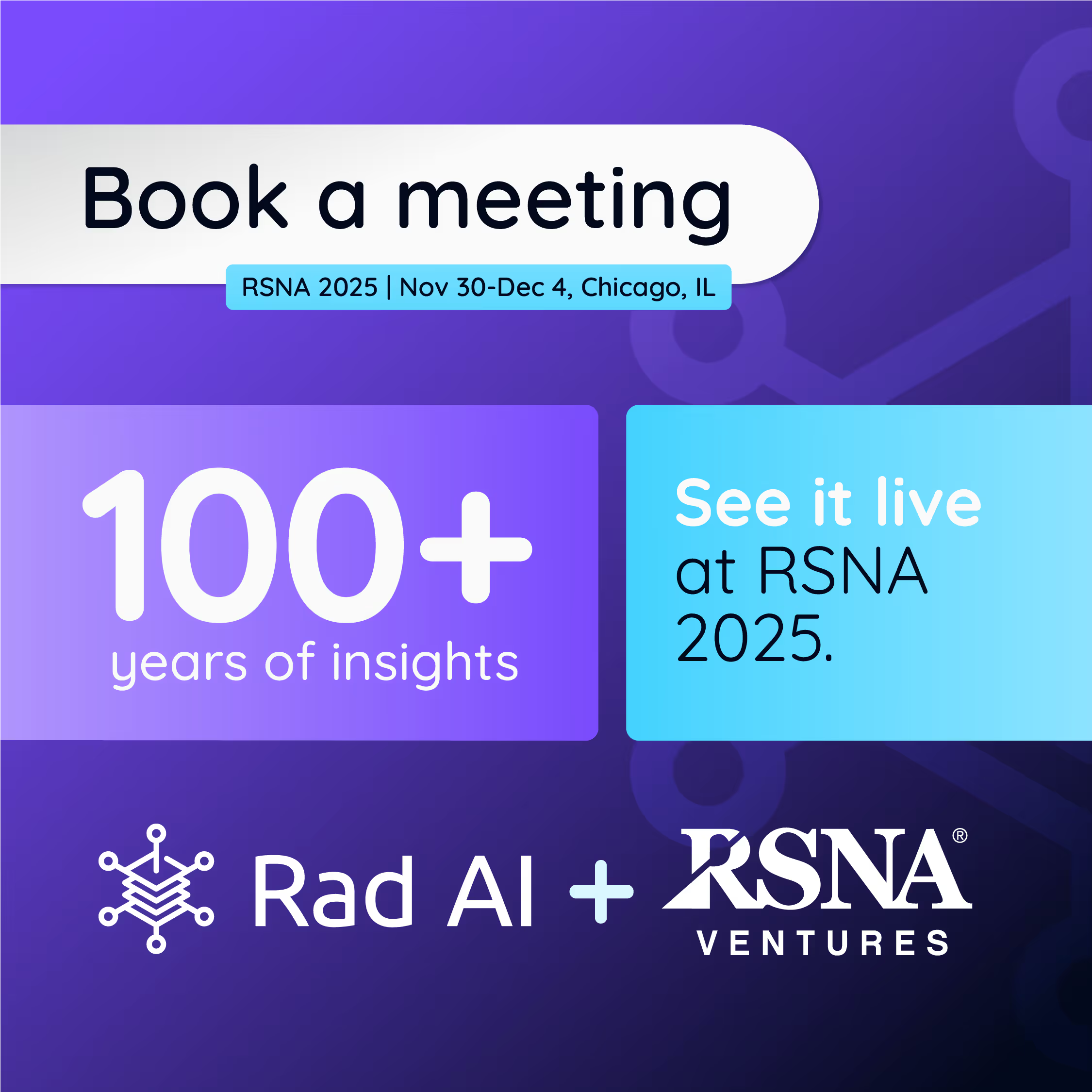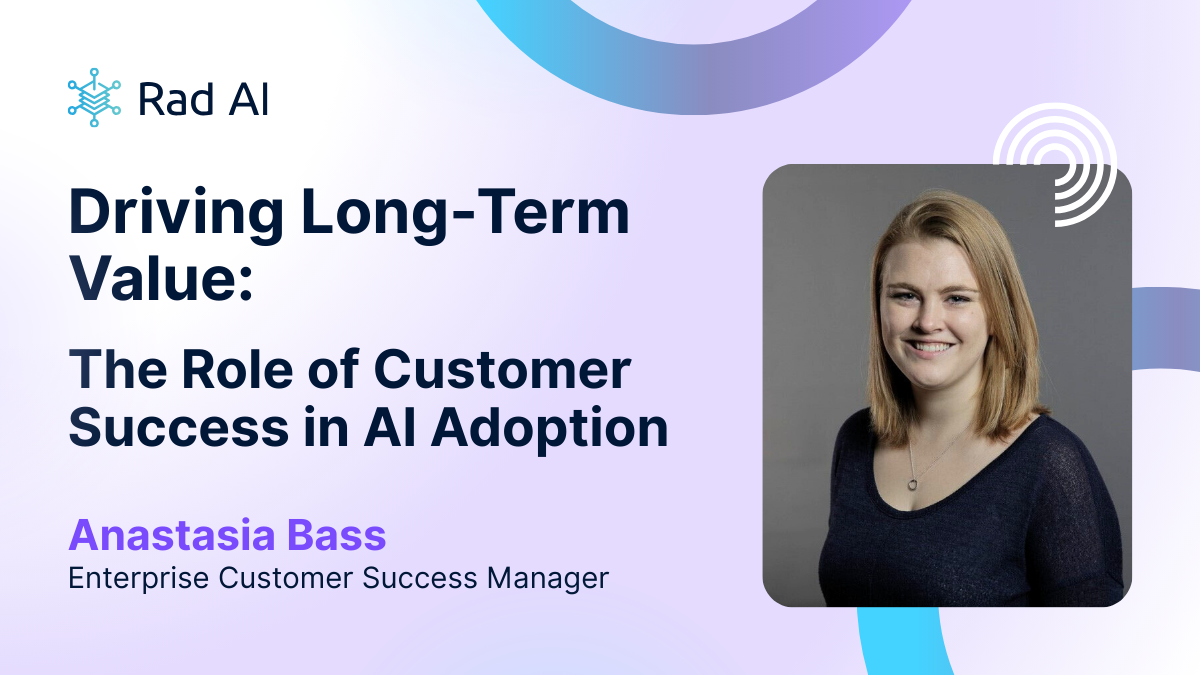The Next Era of Healthcare AI Adoption: Unlocking a Sustainable Future


Radiology has long led the way in healthcare’s technology adoption[1]. From X-ray imaging to Picture Archiving and Communication Systems (PACS) and now to AI, the specialty continues to adopt new tools at a faster rate than any other[1].
This adoption isn’t only about efficiency and speed. It’s a major step toward a sustainable future, with better clinical outcomes, reduced operational burden, and a measurable return on investment (ROI).
1. AI for Personalized Medicine and Patient Outcomes
In practice, personalization is the pathway from AI’s promise to real-world impact. The days of "one-size-fits-all" medicine are quickly becoming a thing of the past. One of the most significant advancements in the next era of healthcare AI will be its role in personalized medicine[2].
AI algorithms are already analyzing vast amounts of data to create highly personalized treatment plans[2]. This involves reviewing patient data points, including:
- Genomic data
- Medical history
- Lifestyle factors
This comprehensive analysis allows clinicians to transition from a reactive to a proactive model, where they can anticipate and prevent diseases before they even manifest[2].
For example, AI can analyze genetic markers to identify a patient's risk for specific conditions like heart disease or cancer. It can then recommend tailored preventive measures, such as dietary changes or targeted screenings[2].
This approach not only improves patient outcomes but also reduces the burden on the healthcare system by focusing on prevention rather than just treatment. In practice, AI in radiology has already demonstrated high accuracy in detecting certain conditions, with some systems improving diagnostic accuracy and increasing specificity to 94% in screening mammography[3].
2. Revolutionizing Medical Research and Drug Discovery
Drug discovery and clinical trials are notoriously long and expensive processes. AI, however, is drastically shortening this timeline[4].
By using predictive modeling and machine learning, AI can analyze massive molecular databases to identify potential drug candidates and predict their efficacy[4]. This accelerates the early stages of drug discovery, allowing researchers to focus on the most promising compounds.
AI is also streamlining medical research by optimizing clinical trials. Algorithms can quickly sift through electronic health records to identify and recruit eligible patients, reducing the time and cost associated with patient enrollment[4].
A 2024 analysis confirmed that AI-discovered drugs have a significantly higher success rate in Phase I clinical trials, achieving success rates between 80% and 90%, compared to the historical average of 40% to 65%[5]. If these results hold, the path from early discovery to Phase I trials could become more direct.
3. Enhancing Clinical Workflow and Reducing Burnout
The healthcare industry is plagued by physician burnout, with professionals spending a significant amount of their time on administrative tasks rather than patient care[4]. The next era of healthcare AI will directly address this by automating routine and repetitive processes.
AI-powered tools can now handle tasks like medical transcription, scheduling, and data entry, freeing up valuable time for clinicians to focus on patient-facing care[4].
Generative AI is revolutionizing clinical workflow. An American Medical Association (AMA) survey in 2025 found that 57% of physicians believe addressing administrative burdens through automation remains the biggest area of opportunity for AI to address key needs[6].
Automating the Impressions section is just one area where AI-powered radiology solutions improve workflow; they offer a full spectrum of capabilities to enhance reporting efficiency, quality assurance, and practice management[4].
For instance, AI solutions can automatically draft the critical "Impressions" section of a report in near real-time, using the radiologist’s own style. This drastically reduces the words dictated, significantly lowering the cognitive burden and saving time[4].
AI's true benefit lies in quietly eliminating the exhausting, repetitive tasks that pull a physician's focus. As one radiologist shared:
“Much of the mental stress from the work that I do is related to vocalizing something that you have in your head, and the only way to get it into a report form is to say it, which slows the radiologist down and requires more mental energy. Personally, I feel that Rad AI takes care of about 99% of that work.”
- Kevin Woolley, MD, FACR, CIA Radiologist
This automation not only saves physicians time but also allows them to be more present and engaged with their patients. To explore this concept further, read "From Fatigue to Focus: How AI Radiology Software Strengthens the Modern Workflow"[7].
4. Ethical Considerations and the Human Touch
As with any powerful technology, the widespread adoption of AI in healthcare comes with significant ethical considerations. Questions of AI bias and data privacy are paramount.
Healthcare leaders must ensure that AI models are trained on diverse and representative datasets to avoid perpetuating existing health inequities[8]. Robust security measures are also crucial for protecting sensitive patient information from cyber threats.
Most importantly, we must remember that AI is a tool to augment, not replace, the human element in healthcare. The "human-in-the-loop" model, where AI handles administrative tasks and provides instant insights, is key to preserving a physician's most valuable assets: their time and clinical expertise. This partnership between human expertise and generative AI (GenAI) is essential to reducing operational friction and refocusing your top talent on delivering critical patient care.
In practice, this partnership also improves quality. Automated reports help radiologists identify and correct clinically significant errors or identify findings that were inadvertently omitted from the report[8].
“We found that misstatements in the findings were duplicated in the impression, and that afforded us an opportunity to go back and correct those discrepancies."
- Sachin Talusani, MD, CIA President
Future Outlook
The next era of healthcare AI adoption promises a future where medicine is more precise, research is faster, and patient care is more compassionate. While challenges remain, the industry's rapid embrace of this technology. The global AI in healthcare market is projected to reach over $504 billion by 2032[9], indicating that the momentum is undeniable. By leveraging AI responsibly and ethically, we can move closer to a healthcare system that is not only smarter and more efficient but also more human-centered than ever before.
References
- King B. How Radiology is Becoming a Leader in Adopting AI. IU Medicine Magazine. December 13, 2024. https://medicine.iu.edu/magazine/issues/winter-2025/how-radiology-is-becoming-a-leader-in-adopting-ai. Accessed October 8, 2025.
- Roundtable on Translating Genomic-Based Research for Health; Board on Health Sciences Policy; Institute of Medicine. Genomics-Enabled Learning Health Care Systems: Gathering and Using Genomic Information to Improve Patient Care and Research: Workshop Summary. Washington (DC): National Academies Press (US); July 8, 2015. https://www.ncbi.nlm.nih.gov/books/NBK316477/. Accessed October 8, 2025.
- New Study: AI-Powered Mammography Yields Major Gains in Cancer Detection, Diagnostic Accuracy. Imaging Technol News. June 9, 2025. https://www.itnonline.com/content/new-study-ai-powered-mammography-yields-major-gains-cancer-detection-diagnostic-accuracy. Accessed October 8, 2025.
- Kumar N, Gowda M. The Role of AI in Streamlining Clinical Trials: Cost and Time Implications. Int J Sci Res Eng Trends. 2022;8(10):2518. https://www.researchgate.net/publication/392912490_The_Role_of_AI_in_Streamlining_Clinical_Trials_Cost_and_Time_Implications. Accessed October 8, 2025.
- Jayatunga MKP, Ayers M, Bruens L, Jayanth D, Meier C. How successful are AI-discovered drugs in clinical trials? A first analysis and emerging lessons. Drug Discov Today. 2024;29(6):104009. doi:10.1016/j.drudis.2024.104009. https://pubmed.ncbi.nlm.nih.gov/38692505/. Accessed October 8, 2025.
- Physicians' greatest use for AI? Cutting administrative burdens. American Medical Association. March 19, 2025. https://www.ama-assn.org/practice-management/digital-health/2-3-physicians-are-using-health-ai-78-2023. Accessed October 8, 2025.
- From Fatigue to Focus: How AI Radiology Software Strengthens the Modern Workflow. Rad AI Blog. https://www.radai.com/blogs/from-fatigue-to-focus-how-ai-radiology-software-strengthens-the-modern-workflow. Accessed October 8, 2025.
- Meskó, Bertalan, and Eric J. Topol. “The Imperative for Regulatory Oversight of Large Language Models (or Generative AI) in Healthcare.” NPJ Digital Medicine, vol. 6, no. 120, 2023. www.nature.com/articles/s41746-023-00919-5. Accessed October 8, 2025.
- AI in Healthcare Market Size, Share | Growth Report [2025–2032].” Fortune Business Insights, 21 July 2025, www.fortunebusinessinsights.com/industry-reports/artificial-intelligence-in-healthcare-market-100534. Accessed October 8, 2025.






